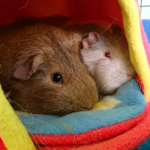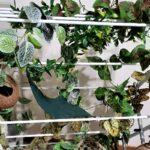Behavioural enrichment aims to enhance the quality of life of captive animals. Providing varied, challenging and stimulating environments will improve the mental and physical well-being of pet birds, which in turn should assist in preventing or reducing abnormal behaviours often associated with captivity.
Suitable enrichment ideas can be acquired by researching the behaviours of wild birds and mimicking or adapting these for pet birds in a captive environment. In Australia we are lucky enough to share our environment with many native parrot species that spend their days eating, foraging, chewing and playing with native plant species. A great many native Australian plants are bird-safe and can be given to all captive birds for enrichment.

Providing blossoms, leaves, seedpods and bark from bottlebrush, grevillea, eucalyptus, banksia and paperbark plants will allow birds to exhibit natural foraging behaviours.
These plants (browse) are an inexpensive, easy method to assist in keeping a parrot entertained for many hours. Providing browse is an excellent way to start introducing pet birds to enrichment opportunities. Most birds, including those who are inexperienced with enrichment, will take to chewing and destroying browse within minutes of it being presented. Choose plants that are not frequented by wild birds or have been sprayed with any chemicals or pesticides.
These plants should be rinsed under clean water before being offered to pet birds. For added safety the browse can be sprayed with F10 disinfectant at a dilution of 1:125, left for 30 minutes and then rinsed with clean water before being given to pet birds.

Some bird safe plants include:
Melaleuca seed & leaves (top left), Melaleuca flowers (top right), Melaleuca bark (middle left), Banksia flower & leaves (middle right), Grevillea flowers & leaves (bottom left), Eucalyptus flowers & leaves (bottom right).
Economical foraging toys can also be made from inexpensive household objects such as newspapers, cardboard packaging, egg cartons, paper towels and toilet rolls.
Fill these objects with desirable, high-value treats and present to pet birds. The object is to encourage the bird to open, chew and destroy these foraging toys in order to get to the treats inside. Inexperienced birds should be introduced to these foraging opportunities slowly and initially might need to be shown that there are treats to be obtained by ripping open the foraging toy for them. Eventually these toys can be made more complicated and challenging for the bird in order to keep them entertained for longer.

Daily offerings of vegetables and fruits can also be utilised as enrichment opportunities. Try to avoid providing a standard plate of perfectly chopped up produce each day as this does not offer any challenges and will quickly become boring for the bird.

Instead try to find novel ways to provide these foods. This can include hanging fruits and vegetables on stainless steel skewers, providing it in its whole form so that the bird has to chew through the skin and seeds to get to the flesh, or even utilising and combining bits and pieces from various fruits and vegetables together such as wrapping treats in corn husks.

Find novel ways to provide fresh produce such as hanging it from stainless steel skewers (left) or providing it in its whole form (right).

Wrapping treats in fresh corn husks can provide birds with a challenge.
A large range of commercial foraging toys are also available. These often come in a variety of shapes, sizes and various levels of difficulty. Have an assortment of these toys available so that they can be rotated in and out of the cage often. This will help prevent the bird from becoming completely familiar with the toy and solving it too easily. Birds might need to be shown how to solve the foraging toy initially before being able to do so themselves.

Commercial foraging toys range in difficulty from very easy to very challenging.
Destructible commercial toys are also a great source of enrichment. Wood, paper and safe plant based toys (such as ones made of dried palm leaves, coconut fibers, corn cobs, pinecones and bamboo) are designed to be destroyed and should be replaced often. Avoid rope toys and perches as some birds will chew and ingest the fibers which can lead to gastrointestinal blockages.
Less destructible toys can also contribute to a good enrichment regime. These toys include ones made out of strong plastics, stainless steel (avoid other metals as contact with these could lead to heavy metal toxicity) and hard woods. Toys of this nature should be rotated in and out of the cage very often to avoid the bird from becoming bored with them.

Small birds should not be forgotten when it comes to providing enrichment! Small parrots such as budgies, lovebirds, cockatiels and conures are intelligent creatures and will benefit from enrichment opportunities just as much as their larger counterparts. Try adapting various enrichment strategies to cater for the smaller size of these birds. Foraging trays are ideal and can be filled with a large assortment of treats to suit individual birds. Filling the tray with native browse, millet sprays, seeds and parrot pellets is a good start. Once the bird has become more comfortable with the idea of foraging for food in a tray then the difficulty level can be ramped up by hiding the treats amongst non-toxic paper cat litter pellets, shredded paper and scrunched up newspaper sheets.

Introduction of a basic foraging tray to budgies.
Try wrapping sheets of paper towel over the opening of feeding cups containing treats to encourage birds to shred the paper before gaining access to the food. Start slowly by first making a small tear in the paper towel so that the bird can see the treats contained inside the cup. Once the bird has learnt that the paper towel is covering food you should be able to leave the paper completely intact for the bird to shred by itself to access the treats.

Smaller parrots do very well when provided with softer, shredable woods such as paperbark which they can easily manipulate with their small beaks. This form of enrichment can be taken a step further by drilling small holes in the wood and stuffing bits of seeds and other treats inside, forcing the bird to chew and work for its food.
Passerine birds such as canaries and finches will need their enrichment adapted to suit their needs as well. These birds often do very well with native browse as it offers them a variety of different textures, shapes and smells. Spray leafy browse such as bottlebrush or eucalyptus with water before presenting to the birds as they will often bathe in between the leaves.

Providing different types of fruits and vegetables are also a good form of enrichment for little passerines. Hang greens such as carrot tops, coriander, parsley and basil in the cage for the birds to peck at or provide slices of fruits with small seeds (such as kiwi fruit, dragon fruit and strawberry) that the birds can spend time meticulously picking out.

Whole dutch carrots fixed along the perch to provide a novel and challenging alternative to a traditional plate of food.
Live foods such as pinhead crickets and small mealworms can also be provided as nutritional and environmental enrichment for some birds. Offering these treats will keep finches busy for quite some time while they chase after the insects in order to catch and eat them.
Having nesting material such as coconut fibers, downy feathers, hay and long-stemmed grasses available will also encourage natural nest building behaviours which will keep small passerines busy for many hours. However, keep in mind that this will lead to breeding behaviour which can have their own set of complications down the line.
Finally, another great enrichment technique is starting a training program for your birds by using force-free training methods. Training is a great way to keep birds active and mentally stimulated. With enough persistence, repetition and positive reinforcement, birds of all sizes and species are capable of being trained. Remember that good, enriching training always means that the bird gets to decide when and to what extent they want to participate. Keep training sessions short and never punish the bird for not following a command. Further reading should be done on positive reinforcement and/or clicker training before instituting a training plan. A good place to start is the Barbara Heidenreich’s Force Free Animal Training website: www.barbarasffat.com

Plum-headed Parakeet demonstrating target training.
Enrichment is an exceptionally important aspect when it comes to owning birds, whether they are parrots or finches, large birds or small, kept indoors or in outdoor aviaries. Bird owners can ensure their pets are enjoying a fulfilling and enjoyable life by incorporating a quality and varied enrichment regime.




